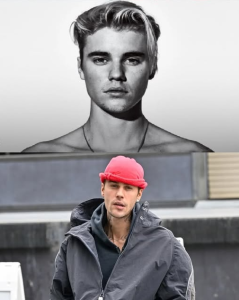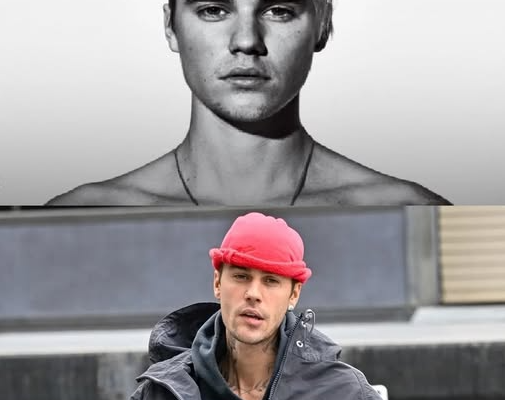
Justin Bieber, one of the most recognizable names in the global music industry, has lived most of his life in the public eye. From his teenage rise to fame to his adult journey through health struggles and self-discovery, every step of his story has unfolded before millions of fans. One of the most discussed topics in recent years has been his openness about his health issues—particularly when he revealed that he had tested positive for COVID-19 and had been dealing with Lyme disease and Ramsay Hunt syndrome. These admissions shed light on the hidden challenges behind the fame, reminding the world that even global superstars are not immune to illness, exhaustion, or vulnerability.
In February 2022, news broke that Justin Bieber had tested positive for COVID-19, shortly after he began his long-anticipated “Justice World Tour.” The diagnosis forced him to postpone several shows, including a major performance in Las Vegas. At that time, Bieber’s representatives confirmed that his symptoms were mild, but the timing was unfortunate given the pandemic’s lingering impact on the entertainment industry. Many fans had waited years to see him live again after the disruptions of 2020 and 2021. Bieber’s quick and responsible response—choosing to rest and delay shows—demonstrated maturity and concern for both his health and his audience’s safety.
However, the COVID-19 infection was not Bieber’s first health setback. In 2020, he made headlines when he revealed that he had been battling Lyme disease, a bacterial infection transmitted through tick bites. The disease had gone undiagnosed for some time, leading to a range of unexplained symptoms, including fatigue, depression, and skin problems. Critics and fans alike had previously speculated about Bieber’s appearance and behavior, but his announcement provided much-needed clarity. On Instagram, he shared, “While a lot of people kept saying Justin Bieber looks like crap, they failed to realize I’ve been recently diagnosed with Lyme disease.” His openness transformed what could have been a moment of weakness into an act of advocacy, raising awareness about a condition that affects thousands of people each year.
The Lyme disease diagnosis also exposed the darker side of fame. Bieber admitted that constant online criticism and speculation about his health took a toll on his mental well-being. He was judged not just for his music, but for his skin, his weight, and his demeanor. His honesty about his struggle helped fans see beyond the glitz of celebrity life, illustrating how fame can amplify both physical and emotional challenges. With treatment, Bieber began to recover, and he shared that faith, therapy, and support from his wife, Hailey Bieber, played a crucial role in his healing process.
But perhaps the most alarming moment came in June 2022, when Justin Bieber posted an emotional video revealing that he had been diagnosed with Ramsay Hunt syndrome type 2. This rare neurological condition, caused by the varicella-zoster virus, resulted in paralysis on one side of his face. In the video, Bieber demonstrated how he couldn’t blink one eye or move half of his mouth. “As you can see, this eye is not blinking. I can’t smile on this side of my face,” he explained, adding that the syndrome had forced him to cancel further shows. Fans around the world flooded social media with messages of support and concern.
The diagnosis marked a turning point for Bieber, who decided to prioritize his health over his career for the first time. Doctors warned that recovery could take weeks or even months, depending on how his body responded to treatment. Bieber took time off from touring and focused on physical therapy and rest. He also leaned heavily on his Christian faith, which he has credited with helping him stay grounded through hardship. “I know this storm will pass,” he told fans, “and in the meantime, I trust God’s plan.”
Over the following months, Bieber made gradual progress. Videos shared by fans showed him regaining movement in his face and smiling again. By 2023, he was strong enough to perform selectively, though he continued to limit his schedule. His team emphasized that his recovery was ongoing, and he would not push himself beyond what was safe. Many saw this as a sign of personal growth; earlier in his career, Bieber had been known for nonstop touring and burnout. Now, he appeared more self-aware, setting healthy boundaries that allowed him to heal both physically and mentally.
Bieber’s willingness to share his medical struggles publicly has had a significant social impact. By talking openly about illnesses such as Lyme disease and Ramsay Hunt syndrome, he has helped to destigmatize conversations about health in the entertainment world. For many young fans, seeing their idol deal with such serious issues yet continue to stay positive provided a model of resilience. He didn’t present himself as a victim but as someone fighting back with courage and faith.
Moreover, Bieber’s journey underscores the importance of empathy in the age of social media. Too often, celebrities are subjected to harsh scrutiny when their appearances change or when they cancel events. In Bieber’s case, rumors about drug abuse or laziness circulated widely before the truth came out. His story serves as a reminder that what the public sees is only a fraction of the full picture. Behind the headlines are human beings managing pain, fatigue, and private battles invisible to the camera.
Hailey Bieber, his wife, has also spoken candidly about the strain these experiences placed on their relationship. Around the same time as Justin’s diagnosis, Hailey herself suffered a mini-stroke due to a small blood clot in her brain. The couple leaned on each other during recovery, emphasizing the power of love and support in overcoming hardship. Their openness about their health has strengthened their public image, portraying them as a grounded and relatable couple despite their fame.
By 2024, Bieber had returned to making music, though at a slower, more deliberate pace. He began to focus on projects that reflected his growth, gratitude, and newfound peace. In interviews, he has spoken about how illness forced him to reevaluate what truly matters. “For a long time, I thought success was about numbers and fame,” he said in one conversation. “But when your body fails you, you realize that health, family, and faith are the real blessings.”
Today, Justin Bieber stands not only as a pop icon but as a symbol of resilience. His health journey—marked by testing positive for COVID-19, battling Lyme disease, and enduring Ramsay Hunt syndrome—has shaped him into a more compassionate and mindful person. He continues to use his platform to advocate for self-care, mental health awareness, and kindness. In a world where perfection is often expected, Bieber’s imperfections have made him more human and, in many ways, more inspiring.
Ultimately, Justin Bieber’s admissions about his health reveal more than a list of diagnoses—they tell a story of growth, humility, and strength. He has learned to slow down, to rest when needed, and to accept that vulnerability is not weakness but a form of courage. Through all the ups and downs, Bieber’s journey reminds us that healing is not linear and that every setback can become a stepping stone toward self-understanding. Whether on stage or in recovery, he continues to shine as a reminder that even the brightest stars sometimes need time to heal before they can truly light up the world again.

